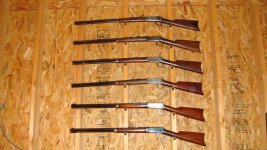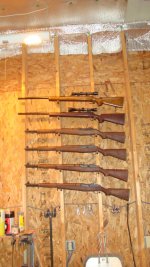A couple of weeks ago I bought a Winchester Model of 1894 rifle from a guy on Gunbroker. The serial number dates this rifle back to late 1907 or early 1908. It is a 30 W.C.F. saddle rig model. The condition of the rifle's exterior is on a par with other rifles from the early 1900's. The majority of the bluing is gone and it looks like the furniture was probably refinished many years ago. Overall, the exterior is in good shape with minor handling scratches. The metal has the typical grey patina.
Now comes the problem. I took this rifle to a gunsmith friend to make sure the rifle would be safe to shoot. Turns out it is not. The leading edges of the lands are rusted the entire length of the barrel. The seller mentioned in his auction verbiage that the potential buyer should have the rifle inspected prior to firing it. I was warned, but I bought it anyway. I now have an expensive piece of "wall decoration".
Is there any gunsmithing practices that can remove this rust so the rifle can be shot? If not, what would an estimate of the rifle's value in the condition it is in?
I have bought and sold many firearms on the internet. This is the first time I have been stiffed (in my opinion). I feel the seller mislead everyone. If he knew of the condition, I feel he should have stated it. Having someone look at it prior to placing it for sale would have been a nice gesture on his part as well.
I would like to shoot this rifle someday, but if not, it will reside in the corner of my gun cabinet for another 107 years.
I know this is not a S&W product, but I also know there are some highly knowledgeable people on this site. I have learned a lot by just lurking. This lead to me starting my collection of older P/R revolvers. Currently holding at seventeen
quality revolvers.
Thanks in advance for any advice on this matter.
Now comes the problem. I took this rifle to a gunsmith friend to make sure the rifle would be safe to shoot. Turns out it is not. The leading edges of the lands are rusted the entire length of the barrel. The seller mentioned in his auction verbiage that the potential buyer should have the rifle inspected prior to firing it. I was warned, but I bought it anyway. I now have an expensive piece of "wall decoration".
Is there any gunsmithing practices that can remove this rust so the rifle can be shot? If not, what would an estimate of the rifle's value in the condition it is in?
I have bought and sold many firearms on the internet. This is the first time I have been stiffed (in my opinion). I feel the seller mislead everyone. If he knew of the condition, I feel he should have stated it. Having someone look at it prior to placing it for sale would have been a nice gesture on his part as well.
I would like to shoot this rifle someday, but if not, it will reside in the corner of my gun cabinet for another 107 years.
I know this is not a S&W product, but I also know there are some highly knowledgeable people on this site. I have learned a lot by just lurking. This lead to me starting my collection of older P/R revolvers. Currently holding at seventeen
quality revolvers.
Thanks in advance for any advice on this matter.


